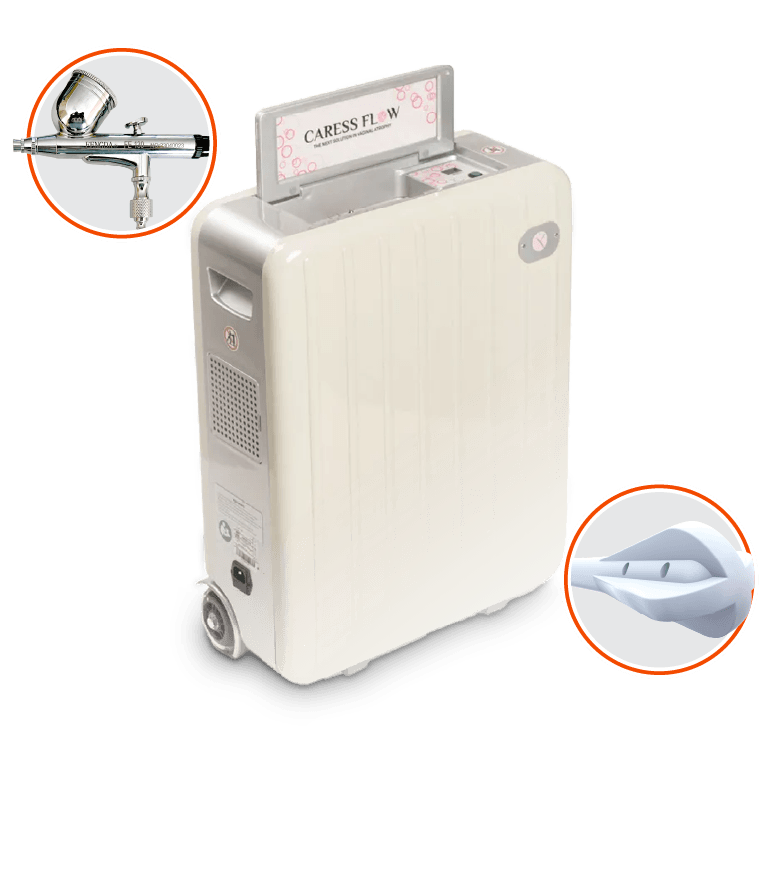Thanks to this treatment, I solved a
nuisance that I had been carrying
around for a long time. I was
almost used to it...
Patient
A non-invasive and safe therapy designed to address six common vaginal health concerns, Caress Flow employs specialised handpieces to guarantee the precise and comfortable administration of oxygen and hyaluronic acid.
This precisely controlled combination initiates a biorevitalizing effect on fibroblasts, encouraging the production of vital components like
collagen1 and elastin2.


The Caress Flow uses specialised airbrush handpieces and
cannulas, which ensure the correct delivery of oxygen and
hyaluronic acid to the vaginal mucosa.
Reactivates microcirculation4,
promotes tissue regeneration,
stimulates cell turnover5, and
acts as an anaerobic
bactericide6.

Known for its high moisturising power⁷, hyaluronic acid complements the effects of oxygen, aiding in tissue repair and elasticity⁴.


















Thanks to this treatment, I solved a
nuisance that I had been carrying
around for a long time. I was
almost used to it...
1. Gordillo GM, Roy S, Khanna S, et al. Topical oxygen therapy induces vascular endothelial growth factor expression and improves closure of clinically presented chronic wounds. Clin Exp Pharmacol Physiol. 2008;35 (8): 957-964.doi10.1111/j.1440 1681.2008.04934.x.
2. Kellar RS, Audet RG, Roe DF, Rheins LA, Draelos ZD. Topically delivered dissolved oxygen reduces inflammation and positively influences structural proteins in healthy intact human skin. J Cosmet Dermatol. 2013;12(2):86-95. doi10.1111/jocd.12039.
3. Condemi L, Di Giuseppe J, Delli Carpini G, Garoia F, Frega A, Ciavattini A. Vaginal natural oxygenation device (VNOD) for concomitant administration of hyaluronic acid and topical hyperbaric oxygen to treat vulvo-vaginal atrophy: a pilot study. Eur Rev Med Pharmacol Sci. 2018;22(23):8480-8486. doi10.26355/eurrev_201812_ 16548.
4. Condemi L, Di Giuseppe J, Delli Carpini G, Garoia F, Frega A, Ciavattini A. Vaginal natural oxygenation device(VNOD) for concomitant administration of hyaluronic acid and topical hyperbaric oxygen to treat vulvo-vaginal atrophy: a pilot study. Eur Rev Med Pharmacol Sci. 2018;22 (23):8480-8486. doi10.26355/eurrev_201812_165485.
5. Zaleski KJ, Kolodka T, Cywes-Bentley C, et al. Hyaluronic acid binding peptides prevent experimental staphylococcal wound infection. Antimicrob Agents Chemother. 2006;50 (11): 3856-3860. doi10.1128/AAC.00082-06.
6. Imlay JA. The molecular mechanisms and physiological consequences of oxidative stress: lessons from a model bacterium. Nat Rev Microbiol. 2013;11 (7):443-454. doi:10.1038/nrmicro3032.
7. Origoni M, Cimmino C, Carminati G, et al. Postmenopausal vulvovaginal atrophy (VVA) is positively improved by topical hyaluronic acid application. A prospective, observational study. Eur Rev Med Pharmacol Sci. 2016;20 (20):4190- 4195.